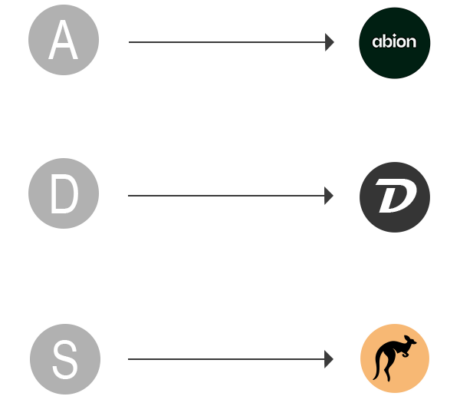
Förbättrad e-postleverans med Verified Mark Certificate
Öka öppningsfrekvensen och varumärkesmedvetenheten med ett Verified Mark Certificate. (VMC). Ett Verified Mark Certified gör möjligt för ditt företag att visa både en Google-checkmark och din logotyp bredvid ditt varumärke i dina kunders inkorg. Kontakta oss så hjälper vi dig att komma igång!
Ökar öppningsgraden
VMC stärker varumärkets synlighet och kan öka öppningsgraden på din e-post med upp till 39%*, beroende på region och marknad.
Visar logotypen
Certifikatet visar Google Checkmark och din logotyp i inkorgen innan e-postmeddelandena öppnas.
Stärker e-postsäkerheten
VMC stärker säkerheten mot phishing och spoofing med DMARC-implementering.
Hur fungerar Verified Mark Certificate (VMC)?
Med ett VMC kan du visa upp din logotyp i verifierade e-postmeddelanden, tack vare den senaste utvecklingen inom BIMI (Brand Indicators for Message Identification). VMC bekräftar juridiskt att din organisation har rätt att använda sin logotyp, vilket säkerställer att den skyddas och visas på rätt sätt.
Förbered för VMC – kriterier att uppfylla
För att få ett certifikat behöver du säkerställa att ditt figur- eller ordmärke är korrekt registrerat och att din e-postinfrastruktur har rätt nivå av säkerhetsskydd.
En varumärkesansökan tar vanligtvis 3-6 månader, och implementeringen av de nödvändiga säkerhetsnivåerna för din e-post kan ta 1-3 månader.

Vilken e-post skulle du öppna?
Är ditt varumärke redo att synas i inkorgen?
Fyll i formuläret så analyserar vi hur redo ditt varumärke är, utan några förpliktelser.
- Vilken logotyp har ni registrerat?
- Om logotypen är registrerad för rätt marknader.
- Säkerhetsnivåerna på din e-post
Implementera VMC för att stärka ditt varumärke
Ett VMC är ett digitalt certifikat som låter företag visa sin verifierade (och varumärkesskyddade) logotyp bredvid sina e-postmeddelanden, vilket stärker varumärkeskännedomen, förtroendet och säkerheten. Genom kravet på DMARC-kompatibilitet säkerställs varumärkets äkthet och skydd mot e-postbedrägerier som spoofing.
Så fungerar Verified Mark Certificates (VMC)
VMC är digitala certifikat som gör det möjligt för organisationer att visa sina registrerade logotyper i det s.k avatarutrymmet för utgående e-post, vilket ger en visuell bekräftelse som hjälper mottagarna att verifiera avsändarens äkthet.
Genom att placera en varumärkesskyddad logotyp bredvid avsändarfältet i mottagarnas inkorgar ökar VMC igenkänningen för ditt varumärke avsevärt samt förbättrar engagemanget för din e-post. Certifikatet hjälper också till att förhindra phishingförsök och e-postförfalskning genom att säkerställa att endast autentiserade e-postmeddelanden kan visa dessa logotyper, vilket ger ett extra lager av säkerhet.
Stödda av stora e-posttjänster som Google, Yahoo Mail och Apple, är VMC på väg att bli en standardfunktion inom e-postmarknadsföring och säkerhetsstrategier. Att implementera VMC och tillhörande tjänster blir avgörande för att hålla jämna steg i den digitala världen.
Steg-för-steg-guide för att skaffa VMC
För att få ett giltigt certifikat krävs flera viktiga steg, som att uppfylla DMARC-krav, ha en registrerad varumärkeslogotyp och skapa logotypen i SVG-format. Varje steg är avgörande för att klara VMC-kraven och lyckas med din VMC-implementering. Processen kan vara komplex, och därför rekommenderas det att ta hjälp av en expert, som Abion, för att få hjälp genom alla steg.
Fördelar med att använda VMC för e-postsäkerhet och varumärkeskännedom
VMC erbjuder flera fördelar utöver e-postsäkerhet. De skyddar mot e-postbedrägerier genom DMARC
teknik mot förfalskning, vilket gör att endast autentiserade e-postmeddelanden kan visa din logotyp. Detta förhindrar phishingförsök, minskar förfalskning och skyddar ditt varumärkes rykte.
Dessutom bidrar det till ökad varumärkeskännedom och engagemang. Företag som använder BIMI och VMC har sett en högre grad engagemang, med en ökning av öppningsfrekvens på upp till 39 %.
Genom VMC och BIMI-specifikationer blir e-postmeddelanden mer synliga i mottagarnas inkorgar, vilket stärker kundernas förtroende och ökar interaktionerna. Att följa punkter som öppnings- och klickfrekvenser ger dessutom värdefulla insikter för dina marknadsföringsstrategier.
Vanliga utmaningar och hur de kan övervinnas
Trots de tydliga fördelarna med VMC-certifikat kan implementeringen innebära vissa utmaningar, som att uppfylla de tekniska kraven, hantera varumärkesregistreringen och den tid det tar att få ett VMC på plats.
Tekniska krav
En stor teknisk utmaning med VMC-implementering är att uppfylla alla krav på e-postinfrastrukturen. Detta innebär att säkerställa DMARC-efterlevnad, korrekt formatering av SVG-logotypen och att e-posten inte är svartlistad, vilket är avgörande för en framgångsrik BIMI-implementering. Tekniska hinder som att skapa en BIMI-kompatibel SVG och konfigurera e-postautentisering kan kännas överväldigande men är viktiga för att säkra ditt VMC-certifikat.
Att uppfylla alla tekniska krav tar tid, men det är nödvändigt för att maximera fördelarna med VMC. På Abion hanterar vi hela processen, så att du kan fokusera på annat.
Problem med varumärkesregistrering
En vanlig utmaning med VMC-certifiering är varumärkesregistreringen, som kan ta från tre månader upp till ett år att slutföra. För en snabb och framgångsrik process är det viktigt att rådfråga en juridisk expert för att säkerställa att alla krav uppfylls, inklusive "användning i handel," där logotypen aktivt måste användas.
Att ta hjälp av en varumärkesspecialist, som Abion, ökar chanserna för en lyckad ansökan. Vi hjälper dig att navigera i registreringsprocessen och ser till att din logotyp uppfyller alla juridiska krav för att vara redo för VMC-certifiering.
Slutsats
Sammanfattningsvis kräver ett VMC-certifikat för dina e-postmeddelanden flera viktiga steg, som att uppfylla DMARC-krav, registrera din logotyp och skapa den i SVG-format. Trots en del utmaningar är VMC en värdefull investering, med fördelar som förbättrad e-postsäkerhet, stärkt varumärkeskännedom och ökad öppningsgrad.
FAQ om Verified Mark Certificate
Ja, .mobile är utvecklad för stabil drift över tid. Med korrekt hantering och förnyelser fungerar den som en del av både dagens och framtida digitala satsningar.
Registreringen går oftast snabbt när namnet är ledigt och uppgifterna är verifierade. De flesta registreringar hanteras samma dag beroende på registrarens handläggningstid.
Kostnaden för ett .uk-domännamn varierar beroende på hur lång registreringsperiod du väljer, hur många domäner du vill ha samt eventuella tilläggstjänster. Du är alltid välkommen att kontakta oss för en prisuppskattning.
Ett brittiskt domännamn är ett bra val när du vill etablera dig i Storbritannien samt i Europa i stort. Det ökar din synlighet, ger geografisk relevans och stärker ditt varumärkesskydd.
För att registrera ett irländskt domännamn måste du kunna visa att du har ett intresse på den irländska marknaden, till exempel genom att uppvisa bevis på handel i Irland.
För företag med moln- eller appbaserade tjänster ger .mobile ger en tydligare och mer samtida identitet än generiska ändelser. Det kan spegla företagets moderna profil och underlätta när man vill särskilja sig i en konkurrensutsatt digital miljö.
Du skaffar ett .uk-domännamn med hjälp av en registrar som har godkänd auktoritet för brittiska toppdomäner. Registraren säkerställer att villkoren uppfylls och hanterar alla administrativa uppgifter.
The UK's top-level domain is an open domain, available for anyone to register. You do not need to be a resident of the country to have a .uk domain.
Relaterade tjänster

Email Security Solutions – Ett måste för alla företag



